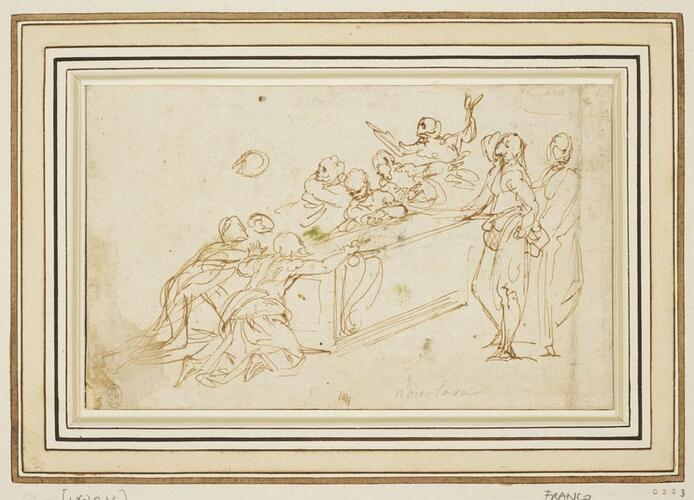-
1 of 253523 objects
Mary Magdalene at the tomb 1547
Pen and ink on buff paper | RCIN 990223

Battista Franco (c. 1510-1561)
Mary Magdalene at the tomb 1547
-
A pen and ink drawing of Mary Magdalene at the Sepulchre, created as a preparatory study for a panel on the polyptych on the main altar of San Leopardo Catherdral, Osimo. Sheet stained in several areas. Inscribed in a later hand in pencil along the lower edge: ‘Novolara’. Stamped in the lower left corner with an Edward VII blind stamp.
Though previously attributed to Lelio Orsi da Novellara and then more widely to the school of Carracci, this drawing has since been recognized as by the Mannerist artist Battista Franco. The drawing depicts Mary Magdalene at the Sepulchre, and is an exploratory study for a painted panel in the fourteen panel polyptych created for the main altar of San Leopardo Cathedral, Osimo. The Royal Collection holds two further studies for the polyptych (RCIN 92220 and 990222). For a wider discussion of the commission and associated preparatory drawings, see 'Battista Franco’s Osimo Polyptych and its Preparatory Drawings', Anne Varick Lauder and Hugo Chapman, Artibus et Historiae, no. 74, XXXVII, 2016, pp. 43-58.
Franco shows figures gathered around Christ’s tomb - Mary Magdalene at the top of the group, her arms raised in supplication. Franco drew rapidly, testing out alternate poses and indicating the heads of several figures with simple ovals. This agile penmanship is characteristic of Franco’s drawings from the late 1540s and 50s. The present sheet differs greatly from the finished painting: Franco removes the group of figures, incorporating them instead in his Accession panel. Franco shows Mary alone - her emotionally charged, open armed pose altered to a more subdued, kneeling one - an angel is included hovering in the air above her. Franco adjusts the horizontal format of the present sheet, rearranging it instead to a vertical, upright composition.
Born in Venice, Franco moved to Rome in his twenties where he became heavily influenced by Michelangelo (1475 – 1564). According to the biographer Giorgio Vasari, drawing was a central way in which Franco assimilated Michelangelo’s style, writing that for a while ‘Franco would do nothing but draw, and would not paint at all’ and that there was no ‘design, or sketch, nay not even a copy executed by Michelangelo’ that Franco did not copy (Giorgio Vasari, Le Vite de' più eccellenti pittori, VI, p. 574). Franco spent the majority of his career in Rome and Urbino, only returning to Venice in the last decade of his life.
Provenance
Royal Collection c.1810, listed in George III’s ‘Inventory A’, c.1800-20, p. 77, ‘Caracci Tom. 8’.
-
Creator(s)
-
Medium and techniques
Pen and ink on buff paper
Object type(s)